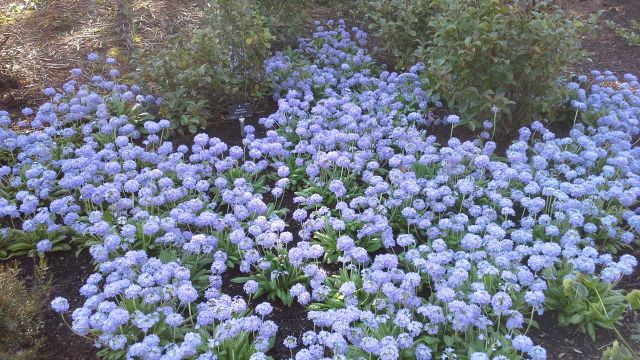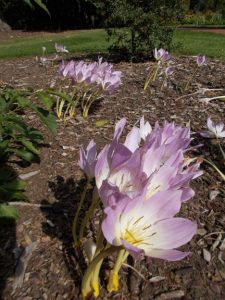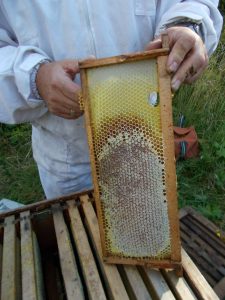January 1st dawned wet and mild, the north block metrological station easily touching 14°C. Walking around the Garden on New Year’s morning; Snowdrops – in flower. A first at RBGE for Galanthus nivalis, we expect these to bloom in February. To complement, there was also one solitary Winter Aconite, Eranthis hyemalis showing colour but still in tight bud. This after 2014 which was the warmest year on record, each of the past four seasons of 2014 recorded temperatures almost 1.5°c warmer than the average. Records also show that this was the mildest New Year’s Day since 1916.
Our first cut of the lawns was made on the 6th January on a day when the gardens metrological station recorded a balmy 11.2°C and ground conditions were dry. Sunshine and a light breeze from the SSW added to the spring like ambiance.
Mid-month storms blew through and snow fell; yet Crocus were showing developed buds with good colour in the lawn at the east gate.
A week of sub-zero overnight temperatures sucked the moisture from the soil and left the blackbirds scratching around in the leaves to uncover their breakfast as the daylight arrived. The early flowers went into a state of suspended animation as temperatures dropped and snow flurries settled on frozen ground.
During February the weather turned dry and by the 12th we had reached the 13th consecutive dry day. Sunshine and frosty nights were also a characteristic of the first half of the month.
March came in, as weather lore decrees, like a lion. The anemometer at the west recorded gusts in excess of 50mph as midnight struck. Sleet showers added to the misery during daylight but the sight of carpets of Snowdrops moving in unison was a reminder that the Met Office officially deems the first as the start of spring.
However unlike the proverb, March did not go out like a lamb. Gales and light snow storms brought the month to an end, although the Forsythia were blossoming the lawns had not put on the even growth expected of spring.
Swathes of Primula denticulata brightened the peat walls in the week after Easter. The Magnolias were also at their best during early April. Indeed April was the month we thought spring would last forever, warmth and settled conditions through most of the month allowed blossom to flourish and fresh young growth to expand. Unfortunately temperatures plummeted and hail storms concluded the month.
May was cold, much lower temperature than usual. The foliage on the Geraniums planted out in the Palm House border turned purple overnight following planting. My tomatoes, planted in an unheated glasshouse refused to put on any growth until June. Usually, these romp away and need strings to support the growth within 10 days of planting. Not this year.
It was the middle of June when the sun warmed us and even then the coolness of the evenings was evident. Although temperatures were low many days of gusting wind caused soil moisture deficit through full leaf tree canopies sucking water from the soil to keep hydrated.
June was the month when, after many years of waiting the Amorphophallus titanum flowered. The first time the Titan Arum had flowered in Scotland and it drew crowds for days. The draw being its accolade as the smelliest flower. It opened early evening of Friday 26th June and the smell of rotting flesh could be experienced in the corridor, thirty paces away.
When the highest July temperature recorded in Britain (36.7°C) occurred on 1st July at Heathrow we were a more comfortable 23°C. Apart from that initial burst of heat, what can i say of July, the grass grew prolifically, turn your back and the mower was needed again. The Atlantic lows kept the temperature down and the sun behind clouds during July. Looking at the cards from the sunshine recorder there are very few that were burnt in a continual line showing a full day of sunshine. Most days we had intermittent sun then cloud cover. Even the butter on the kitchen table was not soft enough to spread as low temperatures continued throughout July, recording an overnight low of 7.6oc on the 9th: Miserable.
August improved and then September arrived with settled weather and the borders of tender perennials and South African bulbs revelled in the climate of SE Scotland. The Autumn Crocus, Colchicum speciosum were stretching due south craning the flower stalks at awkward angles to give the open goblet of petals maximum exposure to the heat.
The bee hives placed in the rough meadow behind the east gate lodge produced a good quantity of honey. Brian the beekeeper explained that the dark colour of honey in the plates is indicative of the bees feeding on Himalayan Balsam. Huge swathes of this are found due south of the Garden on the banks of the Water of Leith. The bees arrive back at the hive with a white stripe down their back, pollen traces from rubbing against the anthers on entering the flower.
The dry weeks of September and much cooler overnight temperatures gave a good start to the autumn colour. Sunshine and warmth were with us for the best seasonal weather for decades.
On the last day of September the sun shone from 6.30am continually until 5.15pm. To start October, on the first we had continual sunshine for eight hours. Both days saw a spectacular sunrise and sunset. Temperatures in the high teens/ low 20’s were achieved on many successive days.
October brought a slow and prolonged autumn colour season. The benign weather and lack of rain saw tree canopies colour spectacularly. Another benefit of the mild autumn was the tomato harvest, not the tastiest, but my plants, following a slow spring establishment produced a bountiful crop that ripened fully. Compliment this with a vase full of freshly picked sweet peas on the last day of October that still scented the room and there may be benefits to our changing climate!
As the winter arrived so did the rain and any perceived benefits of a warmer climate disappeared. We experienced the wettest November since 1976 and this was followed through December by storms that fell onto already saturated ground making it difficult to garden.
In the middle of December the birds provided a mini dawn chorus on the way to work around 7.00am, the night had been so mild. The other interesting fact with these unseasonably high temperatures at this time of year is the absence of windchill.
The data below was taken from the garden weather station following a mild night with a high of 16.4°c recorded at 6.00am.
Conditions at local time 10:35 on 19 December 2015
Temperature and Humidity
Temperature 15.4 °C
Windchill 15.4 °C
The question being; will there be a showing at RBGE of Winter Aconites on New Year’s Day 2016 following this exceptionally mild weather?
Best wishes for a happy and healthy 2016 with opportunities to garden and grow plants to perfection.



